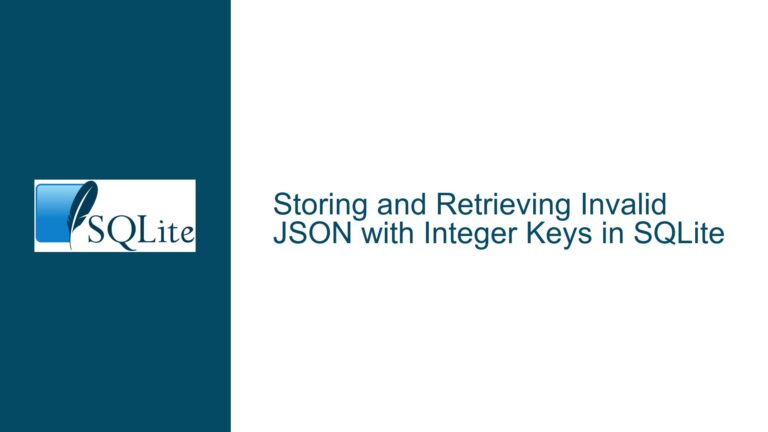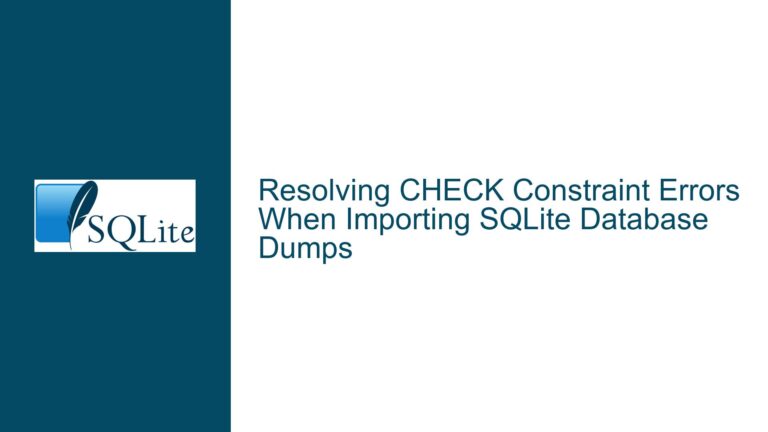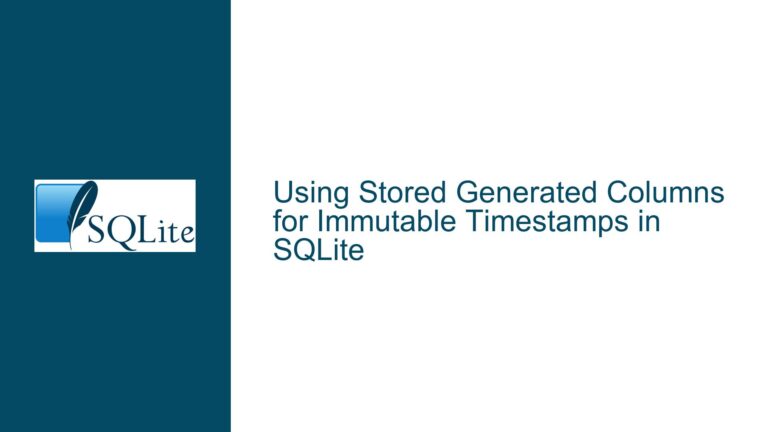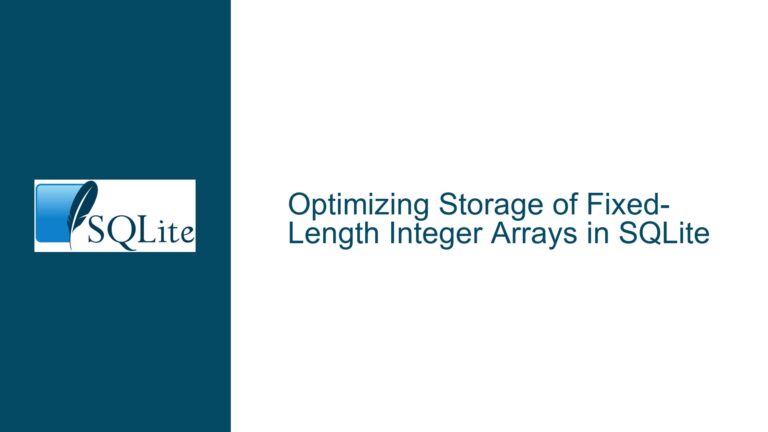SQLite View Modification Challenges and Alternatives to ALTER VIEW
Issue Overview: Absence of ALTER VIEW and Dependency Management Risks
The absence of an ALTER VIEW command in SQLite creates a critical challenge when modifying the definition of an existing view. Unlike databases such as HSQLDB, which allow direct modification of a view’s underlying SELECT statement via ALTER VIEW, SQLite requires developers to execute DROP VIEW followed by CREATE VIEW to achieve similar results. This two-step process introduces risks of dependency dereferencing, where other database objects (e.g., triggers, stored procedures, or application code) referencing the original view may break if the view is temporarily removed. The problem is exacerbated in environments like LibreOffice Base, where graphical interfaces or extensions (e.g., SQLiteOOo) abstract SQL operations, making dependency tracking less transparent.
The core issue revolves around SQLite’s intentional design choice to omit ALTER VIEW due to its lightweight architecture. While ALTER TABLE exists for limited schema modifications, views are treated as static objects once created. This design prioritizes simplicity and performance but complicates scenarios where views must evolve without disrupting dependent components. For instance, if a view SalesReport is referenced by a trigger UpdateInventory, dropping and recreating SalesReport invalidates UpdateInventory until the view is recreated. In distributed systems or applications with persistent connections, this temporary invalidation can cause runtime errors or require complex synchronization logic.
Possible Causes: Architectural Constraints and Dependency Graph Complexity
The lack of ALTER VIEW in SQLite stems from three interrelated factors:
Schema Modification Paradigm: SQLite’s
ALTER TABLEsupport is intentionally limited to operations like renaming tables or adding columns, avoiding the complexity of in-place schema transformations. Extending this to views would require maintaining backward compatibility and handling edge cases like recursive view dependencies, which conflicts with SQLite’s minimalist philosophy.Ephemeral View Metadata: Views in SQLite are defined by their
CREATE VIEWstatement stored in thesqlite_schematable. Unlike tables, which store data and schema separately, views are virtual objects with no persistent state beyond their definition. Modifying a view’sSELECTstatement would necessitate updating this metadata atomically, a feature not supported by SQLite’s transaction model for schema changes.Implicit Dependency Tracking: SQLite does not maintain an explicit dependency graph between views and other objects. For example, if View A references View B, dropping View B invalidates View A, but SQLite does not provide built-in mechanisms to detect or repair such dependencies automatically. This forces developers to manually track dependencies or risk runtime errors.
In environments like LibreOffice Base, these limitations are magnified. GUI tools often generate SQL dynamically, obscuring direct control over transaction boundaries and dependency chains. When a user modifies a view through a graphical editor, the tool may silently execute DROP VIEW and CREATE VIEW without warning about cascading invalidations, leading to unexpected behavior in downstream queries or application logic.
Troubleshooting Steps, Solutions & Fixes: Mitigating View Modification Risks
To address the absence of ALTER VIEW, developers must adopt strategies that minimize dependency disruption and ensure atomicity during view redefinition. Below are actionable solutions organized by complexity and use case:
1. Transactional View Redefinition with Dependency Isolation
Wrap the DROP VIEW and CREATE VIEW operations within an explicit transaction to ensure atomicity. This prevents intermediate states where the view is undefined, reducing the window during which dependencies might dereference:
BEGIN TRANSACTION;
DROP VIEW IF EXISTS SalesReport;
CREATE VIEW SalesReport AS SELECT ...; -- New definition
COMMIT;
Advantages: Simple to implement; ensures the view is either fully dropped and recreated or neither.
Limitations: Does not resolve dependencies on the view from other schema objects (e.g., triggers, other views). These may still reference the view during the transaction, leading to errors if accessed concurrently.
2. View Renaming and Shadow Replacement
Rename the original view to a temporary name, create the new view with the original name, and then drop the renamed view. This approach allows dependent objects to reference the original view until the new one is ready:
PRAGMA foreign_keys = OFF; -- Disable foreign key constraints if necessary
ALTER VIEW SalesReport RENAME TO SalesReport_old;
CREATE VIEW SalesReport AS SELECT ...; -- New definition
DROP VIEW SalesReport_old;
PRAGMA foreign_keys = ON;
Note: SQLite does not natively support ALTER VIEW RENAME. To achieve this, you must update the sqlite_schema table directly, which is not recommended due to corruption risks. Instead, use a procedural approach:
BEGIN TRANSACTION;
-- Backup original view definition
CREATE VIEW SalesReport_backup AS SELECT ...; -- Copy of original SELECT
DROP VIEW SalesReport;
CREATE VIEW SalesReport AS SELECT ...; -- New definition
DROP VIEW SalesReport_backup;
COMMIT;
Advantages: Reduces downtime for the view; dependencies can transition gradually.
Limitations: Requires manual recreation of the view’s original state as a backup, increasing complexity.
3. Dependency Graph Analysis and Automated Scripting
For complex systems with deep dependency chains, automate the discovery of objects referencing the target view and regenerate them after view modification. Use SQLite’s sqlite_schema table to extract dependency information:
-- Find all objects referencing 'SalesReport'
SELECT name, sql
FROM sqlite_schema
WHERE type IN ('view', 'trigger')
AND sql LIKE '%SalesReport%';
Workflow:
- Extract the current definitions of dependent objects.
- Drop the original view and recreate it with the new definition.
- Redefine dependent objects using their extracted SQL.
Automation Example:
import sqlite3
def redefine_view(db_path, view_name, new_definition):
conn = sqlite3.connect(db_path)
cursor = conn.cursor()
# Step 1: Find dependencies
cursor.execute("""
SELECT name, type, sql
FROM sqlite_schema
WHERE type IN ('view', 'trigger')
AND sql LIKE ?""", ('%' + view_name + '%',))
dependencies = cursor.fetchall()
# Step 2: Backup dependencies
backup = []
for name, type_, sql in dependencies:
backup.append((name, type_, sql))
# Step 3: Drop and recreate view
cursor.execute("DROP VIEW IF EXISTS " + view_name)
cursor.execute(new_definition)
# Step 4: Recreate dependencies
for name, type_, sql in backup:
try:
cursor.execute(f"DROP {type_} IF EXISTS {name}")
cursor.execute(sql)
except sqlite3.Error as e:
print(f"Error recreating {type_} {name}: {e}")
conn.commit()
conn.close()
Advantages: Handles cascading dependencies systematically.
Limitations: Requires parsing SQL definitions, which may contain complex or dynamic elements.
4. Leveraging Extension Mechanisms and Workaround Layers
Extensions like SQLiteOOo or custom procedural layers can abstract view modification behind a safer interface. For instance, a wrapper function could enforce transactional view replacement and dependency checks:
-- Hypothetical extension command
SELECT ooo_alter_view('SalesReport', 'SELECT ...');
Implementation Strategy:
- Develop a C-language SQLite extension that intercepts
ALTER VIEW-like commands. - Use shadow tables or versioned schemas to stage view changes without dropping the original.
Advantages: Mimics native ALTER VIEW behavior without requiring SQLite core changes.
Limitations: Requires external code maintenance and may not integrate seamlessly with all tools.
5. Adopting Materialized Views or Hybrid Tables
For frequently modified views with heavy dependencies, replace the view with a materialized view (a table populated periodically). This decouples the view’s logical definition from its physical storage:
-- Create a table mirroring the view's structure
CREATE TABLE SalesReport_materialized (
...
);
-- Populate the table periodically
REPLACE INTO SalesReport_materialized
SELECT ...; -- Original view definition
Advantages: Eliminates view dependency risks; modifications only affect the table population logic.
Limitations: Increases storage overhead and requires manual refresh logic.
Conclusion
While SQLite’s lack of ALTER VIEW poses challenges, developers can mitigate risks through transactional scripting, dependency analysis, and architectural workarounds. Choosing the right strategy depends on the application’s tolerance for downtime, complexity of dependencies, and willingness to adopt external tooling. In scenarios requiring high availability, combining transactional guards with automated dependency regeneration offers the most robust solution, aligning SQLite’s minimalist design with real-world operational demands.






